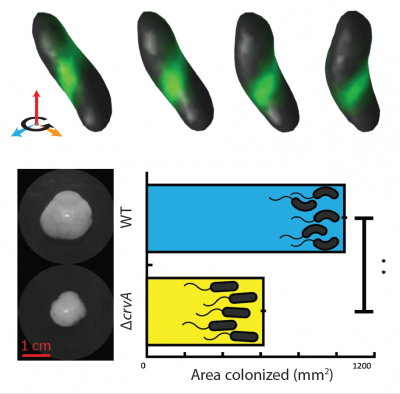Thomas M. Bartlett, PhD

Like animals, bacteria grow in many different shapes, but almost everything that we know about bacterial shape is based on straight rod-shaped cells like E. coli. We combine genetics, biochemistry, biophysics, and cell biology to discover the unique ways that important bacterial pathogens grow into different shapes. Bacterial cell shape is determined by a rigid cell envelope, a 3D structure that surrounds the cell like an exoskeleton, separating and protecting it from a dangerous environment. Thus, our research into cell shape and cell envelope biogenesis identifies hidden vulnerabilities in bacterial growth plans and helps us understand how cell shape contributes to infection and antibiotic resistance. We focus on two pathogens with very different shapes, round Staphylococcus aureus and corkscrew-shaped Vibrio cholerae.
S. aureus is the leading cause of soft-tissue infections, including the notorious methicillin-resistant S. aureus (MRSA). Staph cells are nearly spherical and rely on passive diffusion to move around. However, this simple shape masks hidden complexity – Staph achieves its remarkably symmetrical shape by rotating its division plane in 3D between successive cell cycles. Our studies into S. aureus cell division identified a wealth of new shape determinants, including FacZ, the first division placement factor discovered in Staph or any other round bacterium. We are now exploring the roles of these novel factors in infection and antibiotic resistance.
V. cholerae causes the diarrheal disease cholera, which kills tens of thousands a year in the developing world. In contrast to symmetrical Staph, V. cholerae grows into a complex corkscrew shape. We discovered the curvature system of V. cholerae, CrvAB, and showed that V. cholerae’s corkscrew curvature helps it to penetrate the gut and cause cholera. We are now studying how shape contributes to motility and infection.
Beyond disease, the lessons learned from bacterial cell biology will someday guide the future of nano- and micro-scale engineering, just as animal physiology informs modern robotics. In the future, we hope to understand shape well enough to engineer bacteria of specific shapes for specific applications.
For more information, please visit the Bartlett Laboratory[1] page.

